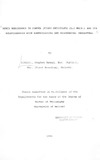| dc.description.abstract | Aphid resistance in cowpea and its relationships with
morphological and biochemical traits was studied in eight
resistant (rev 10, rev 11, rev 12, rT82E-25, Tvu 310, rT87S-
1394, rT87S-1459, and rT84S-2246) and six susceptible (reV
1, rev 5, rev 6" rT83D-237, 'Tvu 946 and Tvu 1509) cowpea
cUltivars, and their F1' F2, F3, and backcross populations.
The main aim of this work was to study the genetic variation
for aphid resistance in some selected cowpea cultivars and
identify heritable, easily identifiable morphological and/or
biochemical markers that could be used for indirect
selection
programmes.
conducted.
The results from these studies indicated that in
cowpea, an antixenosis (non-preference) modality of
resistance was important in the expression of resistance to
aphids. Aphid resistance in each of the eight different
sources of resistance studied was qualitatively inherited
(monogenic) with resistance being dominant to
susceptibility. All sources of resistance carried the same
gene for resistance, Rae, whose expression in different
cultivars was most probably influenced by modifiers.
Wide variations among cultivars were recorded with
respect to most morphological traits studied, except for
days to emergence and pUbescence. All cuItivars could be
distinguished from one another morphologically I except rev
of aphid
Both field
resistant cultivars in breeding
and greenhouse experiments were
10, lev 11 and lev 12. Based on dissimilarities in
morphological traits, the cultivars in this study were
grouped into three maln clusters. Tests for association in a
contingency table indicated that aphid resistance was
associated (P G 0.05) with some morphological traits such as
growth habit, immature pod colour, and seed colour.
eultivars in this study were characterized by very low
genetic diversity for biochemical traits studied. out of 27
isoenzyme loci from 18 enzyme systems studied, only
aspartate amino transferase was polymorphic among cultivars.
The cu Itivars were polymorphic at two. ' electrophoretic
protein bands (62 kD and 23 kD). The biochemical (total
protein and isoenzyme) trait variations were not associated
with aphid resistance (P < 0.05).
This study identified four linkage groups among loci
controlling morphological traits. The proposed linkage group
I carried the loci Fbc and Sw controlling flower bud colour
and swollen stem base, respectively. Linkage group II
carried loci puS, puP, and cbr controlling purple stems,
purple pods (immature) , and cocoa-brown pods (dry) ,
respectively. Loci puS and PuP were tightly linked as
evidenced by low recombination frequency. Linkage group III
carried the loci Pd, Ndt, Hg, and Bpd controlling peduncle
colour, growth habit, plant type I and branching peduncle,
respectively. The aphid resistance gene (Rac) was linked to
locus Pd (30 ± 7.5%) and thus located in this group. Linkage
group IV carried the loci Pt and Bk controlling purple-tip
vi
pods and black pods (mature). Relationships among the four
linkage groups is not known. | en |

